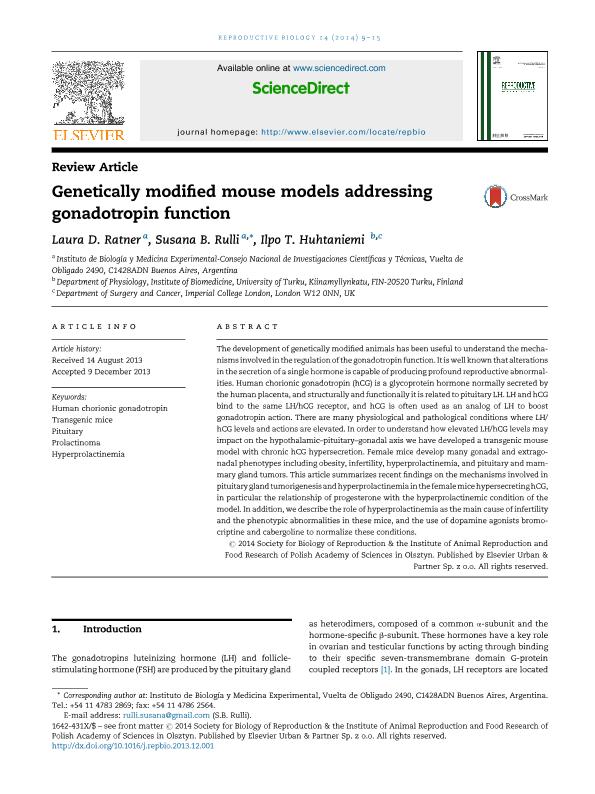Mostrar el registro sencillo del ítem
dc.contributor.author
Ratner, Laura Daniela

dc.contributor.author
Rulli, Susana Beatriz

dc.contributor.author
Huhtaniemi, Ilpo T.
dc.date.available
2017-08-24T20:01:34Z
dc.date.issued
2014-03
dc.identifier.citation
Ratner, Laura Daniela; Rulli, Susana Beatriz; Huhtaniemi, Ilpo T.; Genetically modified mouse models addressing gonadotropin function; Elsevier; Reproductive Biology; 14; 1; 3-2014; 9-15
dc.identifier.issn
1642-431X
dc.identifier.uri
http://hdl.handle.net/11336/22963
dc.description.abstract
The development of genetically modified animals has been useful to understand the mechanisms involved in the regulation of the gonadotropin function. It is well known that alterations in the secretion of a single hormone is capable of producing profound reproductive abnormalities. Human chorionic gonadotropin (hCG) is a glycoprotein hormone normally secreted by the human placenta, and structurally and functionally it is related to pituitary LH. LH and hCG bind to the same LH/hCG receptor, and hCG is often used as an analog of LH to boost gonadotropin action. There are many physiological and pathological conditions where LH/hCG levels and actions are elevated. In order to understand how elevated LH/hCG levels may impact on the hypothalamic-pituitary-gonadal axis we have developed a transgenic mouse model with chronic hCG hypersecretion. Female mice develop many gonadal and extragonadal phenotypes including obesity, infertility, hyperprolactinemia, and pituitary and mammary gland tumors. This article summarizes recent findings on the mechanisms involved in pituitary gland tumorigenesis and hyperprolactinemia in the female mice hypersecreting hCG, in particular the relationship of progesterone with the hyperprolactinemic condition of the model. In addition, we describe the role of hyperprolactinemia as the main cause of infertility and the phenotypic abnormalities in these mice, and the use of dopamine agonists bromocriptine and cabergoline to normalize these conditions.
dc.format
application/pdf
dc.language.iso
eng
dc.publisher
Elsevier

dc.rights
info:eu-repo/semantics/openAccess
dc.rights.uri
https://creativecommons.org/licenses/by-nc-nd/2.5/ar/
dc.subject
Human Chorionic Gonadotropin
dc.subject
Hyperprolactinemia
dc.subject
Pituitary
dc.subject
Prolactinoma
dc.subject
Transgenic Mice
dc.subject.classification
Bioquímica y Biología Molecular

dc.subject.classification
Medicina Básica

dc.subject.classification
CIENCIAS MÉDICAS Y DE LA SALUD

dc.title
Genetically modified mouse models addressing gonadotropin function
dc.type
info:eu-repo/semantics/article
dc.type
info:ar-repo/semantics/artículo
dc.type
info:eu-repo/semantics/publishedVersion
dc.date.updated
2017-08-08T14:23:51Z
dc.identifier.eissn
2300-732X
dc.journal.volume
14
dc.journal.number
1
dc.journal.pagination
9-15
dc.journal.pais
Polonia

dc.journal.ciudad
Olsztyn
dc.description.fil
Fil: Ratner, Laura Daniela. Consejo Nacional de Investigaciones Científicas y Técnicas. Instituto de Biología y Medicina Experimental. Fundación de Instituto de Biología y Medicina Experimental. Instituto de Biología y Medicina Experimental; Argentina
dc.description.fil
Fil: Rulli, Susana Beatriz. Consejo Nacional de Investigaciones Científicas y Técnicas. Instituto de Biología y Medicina Experimental. Fundación de Instituto de Biología y Medicina Experimental. Instituto de Biología y Medicina Experimental; Argentina
dc.description.fil
Fil: Huhtaniemi, Ilpo T.. University of Turku. Institute of Biomedicine; Finlandia. Imperial College London; Reino Unido
dc.journal.title
Reproductive Biology

dc.relation.alternativeid
info:eu-repo/semantics/altIdentifier/url/http://www.sciencedirect.com/science/article/pii/S1642431X13003082
dc.relation.alternativeid
info:eu-repo/semantics/altIdentifier/doi/http://dx.doi.org/10.1016/j.repbio.2013.12.001
dc.relation.alternativeid
info:eu-repo/semantics/altIdentifier/pmid/24607250
Archivos asociados
